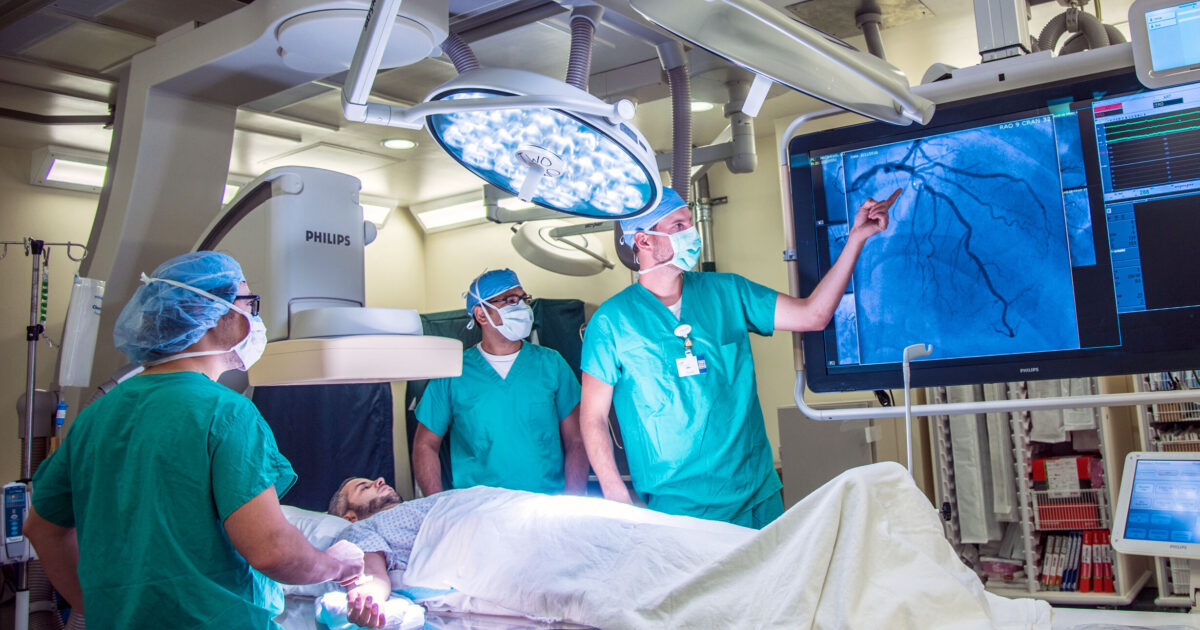What to expect from your first Cardiologist near me appointment
What to expect from your first Cardiologist near me appointment
Blog Article
Comprehending the Relevance of Cardiology in Modern Medical Care Providers
Cardiology plays a critical role in modern healthcare, particularly as cardiovascular disease remains to be the leading reason for mortality worldwide. Advancements in diagnostics and treatment have transformed patient care, enabling earlier treatments and boosted end results. Additionally, the shift towards precautionary cardiology equips individuals to manage their wellness proactively. As modern technology remains to progress, the combination of innovative solutions might additionally redefine cardiology's influence on public health and wellness, prompting a more detailed exam of arising trends and their implications.
The Occurrence of Cardiovascular Disease and Its Influence On Public Wellness
Although heart condition stays the leading reason of fatality worldwide, its impact expands far past private patients to influence public health and wellness systems and economies. The high frequency of heart illness positions a considerable pressure on health care sources, requiring raised funding for therapy, recovery, and prevention programs. Public wellness initiatives need to address danger variables such as obesity, cigarette smoking, and less active lifestyles, which contribute substantially to the rising incidence of heart conditions.Moreover, the financial burden connected with heart problem is tremendous, encompassing not only straight clinical prices but likewise indirect costs connected to shed productivity and premature mortality. Neighborhoods encounter challenges in managing these costs, often resulting in variations in medical care accessibility and outcomes. As the population ages and lifestyle-related risks continue to escalate, the urgency for reliable cardiology interventions becomes critical. Subsequently, addressing cardiovascular disease is not only a matter of individual health and wellness however likewise an important public wellness concern.
Advances in Heart Diagnostics and Imaging Techniques
Current innovations in cardiac diagnostics and imaging techniques have actually changed the area of cardiology, improving the ability to spot and monitor heart conditions. Strategies such as cardiac MRI, CT angiography, and echocardiography have come to be progressively advanced, providing detailed pictures of cardiac structures and features. These modalities allow for the very early identification of problems like coronary artery illness, cardiac arrest, and valvular disorders.Moreover, innovations in non-invasive diagnostics, such as wearable innovation and remote monitoring tools, have empowered individuals and health care service providers. These devices help with real-time monitoring of heart rhythms and other essential indicators, resulting in prompt interventions. In addition, synthetic knowledge is being integrated right into imaging analysis, enhancing precision and effectiveness in medical diagnosis.
Developments in Therapy Options for Heart Issues
Recent improvements in cardiology have actually resulted in substantial developments in therapy alternatives for heart conditions. These consist of advanced surgical strategies that enhance procedural results and arising medications that use brand-new avenues for treatment. As the area evolves, these advancements play an essential role in enhancing individual treatment and outcomes.
Advanced Surgical Techniques
Advancements in medical strategies have transformed the landscape of cardiology, using brand-new wish for patients with heart conditions. Minimally invasive treatments, such as catheter-based treatments, have actually substantially reduced healing times and healthcare facility keeps. Techniques like robotic-assisted surgical treatment boost precision, allowing doctors to navigate intricate physiological frameworks with higher accuracy. Moreover, innovations in imaging technology facilitate real-time visualization throughout procedures, boosting outcomes. Transcatheter aortic valve substitute (TAVR) exhibits a breakthrough in dealing with aortic stenosis, enabling shutoff substitute without open-heart surgical procedure. Furthermore, hybrid approaches that combine catheter-based and surgical techniques supply customized remedies for numerous cardiac problems. These advanced medical strategies not just improve client safety however additionally broaden therapy choices, emphasizing the essential role of development in contemporary cardiology techniques.
Arising Medicines and Treatments
As the landscape of cardiology proceeds to evolve, arising therapies and medicines play a critical duty in improving therapy choices for heart disease. Advancements such as unique anticoagulants and advanced lipid-lowering agents have actually changed the management of heart diseases, significantly lowering patient morbidity and mortality. In addition, the advancement of gene therapies and regenerative medication supplies promising avenues for treating problems formerly deemed irreversible. Scientific trials are continuously disclosing the efficacy of these therapies, pressing the limits of traditional therapies. The combination of digital health technologies helps with individualized medicine, allowing for customized therapy strategies based on genetic and way of life factors. Jointly, these improvements emphasize the dynamic nature of cardiology, improving person results and redefining standards of care in modern healthcare.
The Duty of Preventive Cardiology in Person Care
Preventative cardiology plays an essential function in client care by concentrating on the recognition of danger factors that contribute to heart problem. Via way of life adjustment methods and very early detection strategies, doctor can successfully decrease the incidence of cardio occasions - Cardiology Jupiter. This aggressive strategy not just enhances person outcomes yet likewise promotes lasting health
Risk Variable Recognition
While cardio diseases continue to be a leading reason for morbidity and death worldwide, reliable threat aspect identification works as a cornerstone of preventative cardiology. Recognizing risk variables such as hypertension, diabetes, family members, and hyperlipidemia history is essential for early intervention. Medical care professionals make use of numerous evaluating techniques to examine these aspects, permitting for Dr Garcia tailored precautionary steps. In addition, understanding a person's way of life choices, such as smoking and physical inactivity, additionally educates risk assessments. This complete examination makes it possible for clinicians to create personalized care strategies aimed at mitigating risks. By prioritizing danger factor identification, healthcare systems can improve patient end results and minimize the overall problem of heart diseases, eventually adding to improved public wellness methods and source allotment.
Way Of Living Alteration Methods
A wide range of studies highlights the important role of way of life modification techniques in decreasing cardiovascular illness danger. These strategies encompass nutritional adjustments, raised exercise, smoking cigarettes cessation, and weight administration. By adopting a heart-healthy diet plan rich in fruits, vegetables, whole grains, and lean proteins, people can reduce cholesterol degrees and high blood pressure. Normal physical activity reinforces the heart and enhances general cardiovascular health. Additionally, quitting smoking cigarettes significantly lowers the threat of cardiovascular disease and improves recovery rates for those with status quo. Weight administration even more contributes to cardio wellness by mitigating other threat aspects such as diabetes and high blood pressure. Executing these lifestyle transforms not only promotes private wellness yet additionally serves as a foundation of preventative cardiology in individual care.
Early Detection Methods
Lifestyle adjustments greatly add to decreasing heart disease threats, but they are most reliable when combined with very early detection methods. Preventive cardiology highlights the significance of identifying prospective heart issues prior to they intensify right into severe conditions. Methods such as blood pressure surveillance, cholesterol screening, and progressed imaging technologies like echocardiograms play crucial functions in evaluating cardio health. Biomarkers and hereditary screening likewise boost the precision of very early detection, enabling customized precautionary approaches. Regular heart risk analyses equip healthcare companies to step in proactively, possibly protecting against heart strikes and strokes (Cardiology care). By integrating these very early detection approaches right into routine treatment, clients can profit from prompt lifestyle interventions and targeted therapies, ultimately improving and enhancing end results lifestyle
Integrating Technology Into Cardiology Practices
As innovations in innovation remain to reshape different areas, the assimilation of innovative tools and systems right into cardiology practices has become necessary for boosting person care and outcomes. Telemedicine systems permit cardiologists to keep an eye on people from another location, improving access to care while reducing the burden on healthcare facilities. Wearable devices, such as smartwatches, enable continual heart rate surveillance, signaling both doctors and individuals to prospective problems in real-time. In addition, fabricated knowledge (AI) is being used to examine huge amounts of cardiac data, aiding in very early medical diagnosis and individualized treatment plans. Advanced imaging techniques, consisting of 3D echocardiography, boost visualization of heart structures, resulting in a lot more exact interventions. Electronic wellness documents (EHRs) enhance client information monitoring, ensuring that cardiologists have instant accessibility to vital information. Together, these technological innovations are changing cardiology, advertising positive administration and improved wellness results for patients with cardio conditions.
The Significance of Patient Education And Learning and Engagement
Individual education and learning and interaction play a crucial role in the monitoring of cardiovascular wellness. By gearing up people with knowledge concerning their problems, treatment navigate here choices, and way of living changes, health care providers equip people to take an energetic role in their care. This positive strategy can result in enhanced adherence to prescribed medicines, nutritional adjustments, and exercise programs, inevitably reducing the risk of complications.Engagement likewise cultivates a solid patient-provider partnership, urging open interaction and trust fund. When patients feel notified and entailed, they are most likely to voice issues and ask concerns, which can result in much better scientific end results. In addition, academic resources, such as workshops or digital platforms, can improve understanding and promote self-management approaches. On the whole, focusing on individual education and learning and involvement is crucial for enhancing cardiovascular health and wellness, boosting top quality of life, and lowering health care expenses related to cardio conditions.
Future Fads in Cardiology and Their Prospective Effect

Frequently Asked Questions
What Way Of Living Adjustments Can Minimize Heart Problem Risk?
The existing concern addresses lifestyle changes that can substantially decrease cardiovascular disease risk. Cardiology Jupiter. Adopting a well balanced diet plan, involving in routine physical activity, keeping a healthy weight, managing tension, and avoiding tobacco can especially boost cardio wellness
Exactly How Can I Recognize Early Indications of Heart Issues?
Identifying early indicators of heart issues entails tracking signs such as breast discomfort, shortness of breath, exhaustion, and irregular heartbeat. Prompt understanding of these indications can prompt essential medical examination and intervention for far better results.
What Are the Distinctions Between Cardiologists and Cardiac Surgeons?
The distinctions between cardiologists and cardiac doctors hinge on their duties; cardiologists primarily identify and take care of heart disease with non-invasive approaches, while heart cosmetic surgeons do procedures to fix structural heart issues. Each plays an essential, distinct function.

How Often Should I Obtain My Heart Health And Wellness Checked?
The regularity of heart medical examination differs based upon private risk variables. Normally, adults should undertake assessments every one to 2 years, while those with current conditions might require even more regular assessments as suggested by health care professionals.
What Duty Does Genetics Play in Heart Condition Risk?
Genes considerably influences heart illness risk, with domestic patterns indicating acquired conditions. Details genes can incline individuals to high blood pressure, cholesterol problems, and other cardiovascular troubles, highlighting the value of hereditary screening in reviewing heart health and wellness. Heart condition remains the leading reason of death internationally, its effect extends far past individual clients to influence public health systems and economic situations. Public health efforts have to deal with danger factors such as obesity, smoking cigarettes, and sedentary way of lives, which add greatly to the increasing occurrence of heart conditions.Moreover, the financial burden connected with heart illness is tremendous, encompassing not just direct medical expenses however likewise indirect expenditures related to lost efficiency and premature death. Preventative cardiology plays an essential role in person care by focusing on the identification of risk elements that add to heart illness. Fabricated knowledge (AI) and equipment learning are enhancing diagnostics and client tracking, enabling very early detection of heart illness. The differences in between cardiologists and heart surgeons lie in their roles; cardiologists primarily diagnose and manage heart conditions through non-invasive approaches, while heart doctors execute medical treatments to remedy structural heart problems.
Report this page